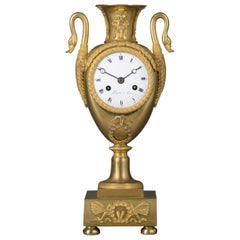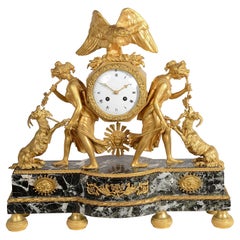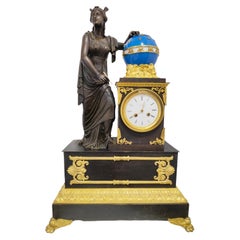Pierre-Basile Lepaute Decorative Objects
to
1
1
1
1
1
1
1
1
Height
to
Width
to
1
1
1
1
1,350
743
487
480
Creator: Pierre-Basile Lepaute
Empire Clock in the Form of a Classical Urn, by Maison Lepautre, circa 1825
By Pierre-Basile Lepaute
Located in Brighton, West Sussex
A gilt bronze Empire clock in the form of a classical urn, by Maison Lepautre.
French, circa 1825.
The dial signed 'Lepaute a Paris'.
The clock has an ornate cast bezel with a 3-inch porcelain dial with Roman numerals and Breguet style hands. The twin train eight-day movement with outside count wheel striking on a bell and silk thread suspension.
This elegant Empire style clock has a gilt bronze case in the form of a classical urn with swan neck handles and a winged cherub to the neck. The circular pedestal base is raised on a footed stepped square plinth.
The Lepaute family were the premier French clockmakers of their day. Their significance lies in their contribution to the clock making industry which had hitherto come under the trade of locksmiths. The family held the brevet Horlogers du Roi.
Jean-André Lepaute (1720–1789) arrived in Paris at an early age and in 1740 founded the family business. A skilled artist and mechanic, he quickly gained an excellent reputation. He was received as maître by the clockmakers guild in 1759, was granted royal lodgings from the king in The Luxembourg Palace, and was entrusted with the construction of the majority of the great public clocks of Paris. He executed, amongst others, those in The Luxembourg Palace, the Jardin des Plantes, the Château de Bellevue and the Château des Ternes. His clock at Paris’s École Militaire still works today. Three editions of his Traité d’Horlogerie were published in Paris in 1755, 1760 and 1767. A small volume, Description de Plusieurs Ouvrages d’Horlogerie appeared in 1764. Jean-André’s wife, Nicole-Reine Etable de la Brière (1723-1788), was a highly esteemed mathematician and astronomer. Her passion for science lent itself to Lepaute’s work and she played an active role in the scientific and mathematical aspects of the clock making.
Jean-André’s younger brother Jean-Baptiste Lepaute (1727-1802) joined him in Paris in 1747 and immediately started working for the family business. He was received as maître in 1776 and was known for the clocks he constructed for the Paris Hôtel de Ville (1780), destroyed in a fire of 1871, and for the Hôtel des Invalides (1784). Jean-Baptiste took over the workshop when Jean-André retired in 1775.
After Jean-Baptiste’s death in 1802, the firm was taken over by his nephew Pierre-Basil Lepaute (1750-1843) where he was duly joined by his own nephew Jean-Joseph (1768-1846) and son Pierre-Michel (1785-1849). By 1816, Pierre-Michel Lepaute was in charge of the business. His masterpieces include the astronomical clock in Paris’s Bureau...
Category
Early 19th Century French Empire Antique Pierre-Basile Lepaute Decorative Objects
Materials
Bronze
Related Items
French Empire Style Mantel Clock, circa 1820
Located in Brighton, Sussex
A very impressive and stylish early 19th Century gilded ormolu and green marble mantle clock, having two classical maidens either side feeding Rams, an Eagle above the circular white...
Category
Early 19th Century French Empire Antique Pierre-Basile Lepaute Decorative Objects
Materials
Marble, Ormolu
Empire Mantel Clock by H.Robert-Horloger De La Reine, Paris, circa 1820
Located in Madrid, ES
An Empire Mantel Clock by H.Robert-Horloger De La Reine, Paris, date circa 1820-1830
A superb Empire gilt and patinated bronze mantel clock of eight day duration signed on the white enamel dial H.Robert-Horloger a la Reine . The dial with Roman numerals and gilded steel Breguet style hands for the hours and minutes. The movement with anchor escapement, silk thread suspension, striking on a single bell, with outside count wheel. The extremely fine case featuring the standing figure of Urania, Muse of Astronomy holding a pen in her left hand which points to a star-studded globe adorned with the signs of the zodiac around its circumference, the globe set on the back of four putti upon a plinth, containing the dial with a serpent-wrapped
Paris, date circa 1820-30
Height 73 cm, width 50cm, depth 22 cm.
In addition to the above prestigious locations, clocks of this model can be found at Warsaw Castle and in the Bayerischen Nationalmuseum, Munich. The Parisian clockmaker Bailly (d. after 1818) was one of the finest of his day and as such earned the title of Horloger de LL. MM. II. Et RR (Clockmaker to Their Imperial and Royal Majesties). Working from rue de Richelieu he was with Lepaute one of the main suppliers to the Garde-Meuble. Bailly, who retired in 1818 had the responsibility of maintaining the clocks at Compiègne and the Trianons and is known to have used cases by the leading Parisian bronziers including Pierre-Philippe Thomire and Claude Galle as well as Ferdinand Schwerdfeger who supplied him with a case for a regulator surmounted by a star-studded and zodiac banded globe...
Category
19th Century French Empire Antique Pierre-Basile Lepaute Decorative Objects
Materials
Bronze
$16,617
H 28.75 in W 19.69 in D 8.67 in
French Empire Period Ormolu Bronze Mantel Clock of Ceres, circa 1815
Located in Shippensburg, PA
A fine Empire period mantel clock with bun feet raising a rectangular base with a central portrait of Bacchus flanked by exquisitely chiseled motif of swirling foliage surmounted by a figure of the goddess Ceres grasping in her lowered hand a wreath woven with foliage and berries while in her garment she collects a bountiful harvest; she rests beside the clock tower with a framed lens opening to access the white enamel dial with black Roman numerals inscribed Etn. Tavernier set with Breguet style hands, raising an urn filled with fruits of the soil; against the tower rest the implements of labor, a shovel and flat rake. The movement is engraved "B". A significant clock movement maker, Etienne Tavernier (French, 1756-1839) is listed in Tardy's horology reference as working closely with the house of Abraham-Louis Breguet as well as providing clock movements...
Category
19th Century French Empire Antique Pierre-Basile Lepaute Decorative Objects
Materials
Bronze, Ormolu
$3,850
H 17.25 in W 12.99 in D 5 in
Allegorical French Empire Clock Referred to as "The Library Clock"
Located in Vancouver, British Columbia
A rare model of a French Empire clock in gilded bronze called The Library, featuring a boy and a girl dressed in classical attire diligently studying in a library, both are sitting on a stool in front of a clock which is integrated into a column which also serves as a bookshelf. The oval clock...
Category
Early 19th Century French Empire Antique Pierre-Basile Lepaute Decorative Objects
Materials
Bronze
Empire Period Mantle Clock by Leroy a Paris
Located in Montreal, QC
This mantle clock is by a well-respected Paris maker in a fashionable style. The oval base supports a vase shaped clock case in turn supported by winged dolphin heads and flanked by ...
Category
1810s French Empire Antique Pierre-Basile Lepaute Decorative Objects
Materials
Bronze, Ormolu
A Homer bust ormolu empire clock in the manner of Thomire
By Pierre-Philippe Thomire
Located in Harrington Park, NJ
AN EMPIRE ORMOLU BUST OF HOMER
After the Antique
The bearded bust of Homer on a rectangular clock decorate with lyres and gryphon heads on the side
Category
Early 19th Century French Empire Antique Pierre-Basile Lepaute Decorative Objects
Materials
Bronze, Ormolu
Grand French Gilt and Patinated Bronze Mantel Clock in the Empire Style
Located in London, GB
Constructed in bronze, patinated and gilt; the rectangular form case supported on engraved oblate spherical feet, the frieze dressed with a row of female masks capping pillars, linke...
Category
19th Century English Empire Antique Pierre-Basile Lepaute Decorative Objects
Materials
Bronze, Ormolu
$74,347
H 28 in W 30 in D 10.5 in
French Empire Gilt Bronze Allegorical Clock of the Astronomical Sciences
Located in Vancouver, British Columbia
A fine example of a period French Empire mantle clock in finely chased and gilded bronze made in France in the first quarter of the 19thC. One of the Greek muses with a star atop h...
Category
Early 19th Century French Empire Antique Pierre-Basile Lepaute Decorative Objects
Materials
Bronze
$3,200
H 15 in W 11 in D 4 in
French Empire Clock Depicting Apollo God of Music and the Arts
Located in Vancouver, British Columbia
A gilt bronze and griotte marble French Empire clock depicting Apollo Greek God of Music Art Literature and Sciences. The clock shows a a gilt bronze winged figure of Apollo leaning against a griotte marble altar pedestal decorated with gilt bronze garlands. At the center of the pedestal is the clock’s dial and movement. Sitting on top of the pedestal is a standing harp, a mallet and a scroll. The whole is supported by a griotte marble base with a gilt bronze frieze showing a number of frolicking and dancing cupids playing music, drinking wine waving laurel wreaths, carrying a standard and even crowning a bust of Athena. The base sits on two owl feet...
Category
Early 19th Century French Empire Antique Pierre-Basile Lepaute Decorative Objects
Materials
Griotte Marble, Bronze
Unusual Early 19th Century Empire Mantel Clock in the Form of an Accanthus Plant
Located in Worpswede / Bremen, DE
Exceptional French Empire Mantel Clock in Gilt and Patinated Bronze
A rare and visually arresting French Empire mantel clock, masterfully crafted in the form of a sculptural acanthus...
Category
Early 19th Century Empire Antique Pierre-Basile Lepaute Decorative Objects
Materials
Bronze
$11,276
H 17.33 in W 14.97 in D 5.71 in
The Astronomy Lesson French Empire Mantel Clock
Located in New Orleans, LA
This magnificent French Empire ormolu mantel clock features the iconic Neoclassical genre scene often referred to as "The Astronomy Lesson." A popular motif during this period, Emper...
Category
19th Century French Empire Antique Pierre-Basile Lepaute Decorative Objects
Materials
Marble, Enamel, Ormolu
French Classical Mantel Clock, circa 1880
Located in Brighton, Sussex
An enchanting classical Louis XVI style gilded ormolu and marble mantel clock, having a standing cherub holding a Cockerel above a white enamel clock face, retails name; Rob. Engstro...
Category
19th Century French Louis XVI Antique Pierre-Basile Lepaute Decorative Objects
Materials
Marble, Ormolu
Pierre-basile Lepaute decorative objects for sale on 1stDibs.
Pierre-Basile Lepaute decorative objects are available for sale on 1stDibs. These distinctive items are frequently made of metal and are designed with extraordinary care. There are many options to choose from in our collection of Pierre-Basile Lepaute decorative objects, although gold editions of this piece are particularly popular. Many of the original decorative objects by Pierre-Basile Lepaute were created in the Empire style in france during the 19th century. If you’re looking for additional options, many customers also consider decorative objects by Claude Galle, Jean-Simon Deverberie, Coduri of Lyon, and France. Prices for Pierre-Basile Lepaute decorative objects can differ depending upon size, time period and other attributes — on 1stDibs, these items begin at $5,425 and can go as high as $5,425, while a piece like these, on average, fetch $5,425.


